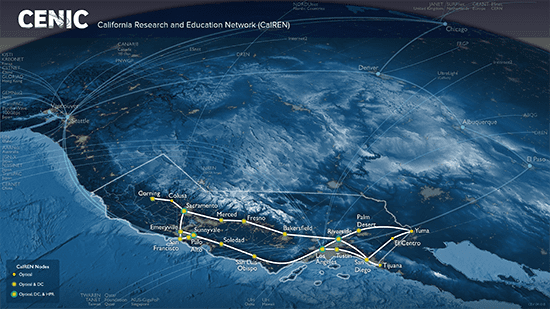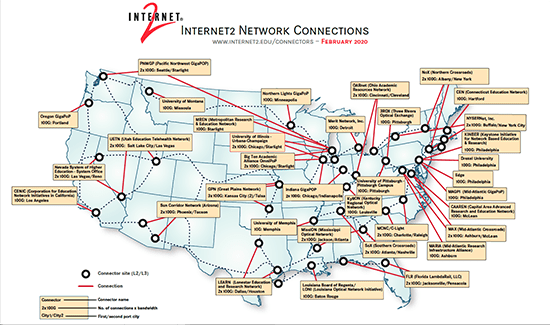Estimated reading time: 9 minutes
By Howard Pfeffer, Internet2 President and CEO, Co-authored by Lous Fox, CENIC President & CEO
One of the most fulfilling aspects of our job is the ability to support the research and education (R&E) community in advancing their academic and service missions. The organizations we proudly serve include colleges and universities, government agencies, regional and state education networks, K-12 schools, public libraries, health care institutions, museums, and cultural and performing arts organizations.
The pandemic has disrupted and impacted every aspect of the day-to-day operations across our communities. Some had to shift to online learning and community engagement. Others to remote access of research data and specialized computing facilities. Everyone had to support work-from-home operations as quickly as possible.
Having a robust national technology environment that is designed by and built for the needs of the research and education community has been at the forefront of our organizational efforts for the last 25 years. And this foresight paved the way for how our organizations have been able to continue supporting our communities, even in the most challenging of times. Even with students and staff off of school and university campuses, our networks still moved about 80% of the traffic they did prior to stay-at-home orders.
We asked some of our members to share how they have adapted their work and continued to fulfill their academic and service missions during the recent stay-at-home orders. We learned that while members’ use of the networks have changed, everyone we heard from said the value of R&E networks like CENIC and Internet2 continues to be realized through the human networks with which they connect; affordable, reliable, and scalable infrastructure, services, and support; public access to digital resources; and advanced networking tools to enable critical scientific research.
The human networks, the users and beneficiaries of the R&E cyberinfrastructure, and the relationships they have with one another, facilitate communities for producing and sharing expertise, data, and resources, whether that be teaching and learning strategies, IT solutions, or broadband access plans.
 Terry Walker
Terry Walker
“The power of this network and the impact it has to connect so many people is incredible,” Walker said. “We are leveraging resources and expertise from across the community in ways that are profound and transformative. We are on the way to doing that and the network accelerates that evolution.”
Meanwhile, on the IT end of the spectrum, R&E networks have been critical for enabling fast, cost-effective collaboration on shared network services amongst the University of California’s six health systems, said Michael Kilpatrick, UC Health technology program director. “We are currently working with CENIC to extend our capabilities up to Seattle on the 100G connection shared by CENIC, Internet2, and Pacific Northwest Gigapop between Sunnyvale and Seattle,” said Kilpatrick. “That is a major opportunity we’re looking at right now to extend our cloud networking capabilities to the Northern regions.”
Campuses collaborate on their approach to cloud services, data centers, and health care applications, providing cost savings, and secure, scalable solutions that might not be available to individual departments or through commercial providers. Kilpatrick’s team recently stood up Microsoft ExpressRoute connections, which are dedicated paths from the campus to Microsoft’s cloud computing offering, within a week of needing them by utilizing the Internet2 Cloud Connect offering. Standing up new connections could take months to get quotes and build-out infrastructure, Kilpatrick said, while membership with R&E networks enables it to be done, in some cases, in as long as it takes to schedule a couple of phone calls.
Easing Transition with Reliable Services
Members say their ability to rely on the network, peering services, cloud services, and identity and access management tools, particularly when it came time to shift gears during stay-at-home orders, allowed for a smoother transition and scalability of services.
At the University of California Berkeley, all of the university’s network services — administrative, academic, and computational —transitioned smoothly into a remote environment during the pandemic, said Larry Conrad, associate vice chancellor and chief information officer. “The COVID-19 experience is truly underscoring that the network enables things people thought they couldn’t do, or would never do, until all of a sudden they had to do,” Conrad said. “Our investment in this R&E community has been the glue that kept it all together.”
 Sylvie Cosgrove
Sylvie Cosgrove
Over the stay-at-home period, many schools, libraries, and universities have enabled parking lots with eduroam, a global wireless network access service developed for the international research and education community.
Cosgrove said the pandemic illuminated the need for WiFi in Stanford’s parking garages for students and faculty who may not have access to high-speed broadband at home. Additionally, the infrastructure easily extended network capabilities to other outdoor areas that are supporting COVID-19 testing.
For Mid-Atlantic Crossroads (MAX) regional network, which serves Maryland, Washington, DC, and Northern Virginia, and is housed at the University of Maryland, Internet2’s network services have become even more critical during the stay-at-home orders, said Jeff Hollingsworth, operator of MAX and chief information officer for UMD. Internet2 NET+ cloud services were critical to providing videoconferencing and multi-factor authentication services, he said. Some services at UMD have improved with remote work, including advising students through videoconferencing and using cloud-hosted software applications rather than on-site computer labs.
Ensuring Constituents Access to Public Services
Network services helped members ensure that their constituents remained engaged with their communities during the pandemic. Institutions are providing more content than ever – on social services such as unemployment, digital literacy and cybersecurity, fake news eradication, teaching and learning materials for students and parents, outreach programs for isolated senior citizens, arts and cultural activities for everyone stuck at home, and more.

Libraries across the country are leveraging their broadband networks to provide services virtually, said Patty Wong, president-elect of the American Library Association and city librarian at the Santa Monica Public Library. “For instance, we just did a Japanese bilingual storytime and we had hundreds of more participants than we ever would have anticipated before because everyone is using that digital environment,” Wong said. “Being part of CENIC is a critical position for libraries. For the millions of Californians who rely on technology to thrive, to stay engaged, to build better lives, and to learn how to be safe, CENIC is a lifeline.” In times of crisis, like the pandemic, she said broadband should be as accessible as electricity and water.
Enabling Critical Scientific Research
Perhaps most pressing, members say R&E network services were key to enabling COVID-19 research, even with scientists working from home or from the field rather than in laboratories.
Many research funding opportunities require access to high-speed networks like CENIC, and Internet2. Connectivity for the US National Institutes of Health, the largest biomedical research agency in the world, is provided by the Mid-Atlantic Crossroads (MAX) and Internet2. The NIH has experienced increased traffic demands, not surprisingly, during the pandemic, but because the network was built to handle these massive scientific workflows, research and operations continued to function.

The CyberInfrastructure for Phylogenetic REsearch (CIPRES) Science Gateway, which provides browser-based access to high-performance computers for thousands of researchers across 90 countries, including those studying COVID-19 solutions, is supported by the CENIC and Internet2 networks. “In two months during the pandemic, at least 164 unique individuals ran hundreds of jobs analyzing coronavirus-related DNA sequences,” said Mark Miller, a bioinformatics researcher at the San Diego Supercomputer Center and principal investigator for CIPRES. “Especially now in COVID times, it would be hard to overstate how important this kind of connectivity is.” Network services, such as Internet2’s Cloud Connect service, accelerate data processing times by providing direct access to leading commercial cloud providers through the existing regional and national infrastructure.
The Pacific Research Platform, also supported by the CENIC network, helped provide computing resources for the crowd-sourced folding@home project, which since February has been focused on computing how a variety of molecules bind to key proteins found in COVID-19. Folding@home connects a rapidly growing number of computers via the Internet and is now the largest distributed supercomputer in the world, consisting of over 3.5 million CPUs and over half a million GPUs. The resulting data is freely available to researchers.
 Larry Smarr
Larry Smarr
Envisioning the Future of R&E Networks
Going forward, whether it be in the short term with schools and universities reopening this fall or five years from now, members resoundingly say R&E networks and the multitude of services they provide, will continue to play an important role in their work. Indeed, the pandemic has highlighted the need for R&E networks to serve their communities in new ways.
One area members cited is the need for Internet access in underserved communities and the potential for R&E networks to help provide infrastructure. “There remain a number of places where the economics have not worked for the commercial providers, creating a need for R&E networks to potentially step up to provide last-mile services,” Hollingsworth said. Wong, who helped develop a broadband plan for Yolo County, a rural agricultural region in northern California, said the plan required everyone – from schools and libraries and fire departments to commercial providers and R&E networks – working together. “It was a win-win for everybody and everyone shared,” she said. “That collaborative spirit needs to be part of the conversation.”
Networks provide critical tools for not only crises like the pandemic, Smarr said, but also for detection and response to disasters such as wildfires, floods, earthquakes, hurricanes, and tornadoes. As more sensors and devices are connected to the Internet, collecting and sharing information about our environment, as part of the Internet of Things, he said an early-warning, multi-hazard situational awareness system is an essential tool for us to be building out across the country.
At whatever point we decide we’re post-COVID-19, remote operations are now going to be a core part of our ethos and our approach, Conrad said. “We’re going to see fundamental and permanent shifts towards a greater virtualized environment.”
Related articles and blogs: